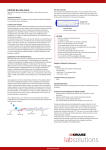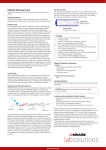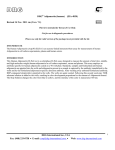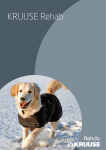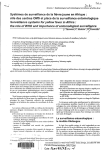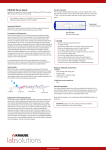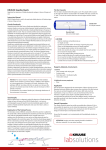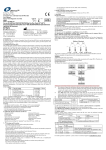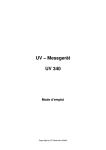Download labsolutions
Transcript
KRUUSE FIV/FeLV Quick If no pathogen is in the specimen, the gold labelled antibodies cannot connect to the immobilized antibodies in the test line region and therefore no test line appears then the test result is negative. Instruction Manual The Test Cassette Rapid test for detection of FIV and FeLV antibodies in whole blood, serum or plasma. KRUUSE FIV/FeLV Quick is used for the detection of specific feline leukemia virus antigen (FeLV) and anti-feline immunodeficiency virus (FIV) antibody in feline whole blood, serum or plasma. FIV and FeLV The test strips are located behind the plastic cover. The sample well is on the right side. The reaction field is located in the middle of the test cassette. The “C” and “T” next to the reaction field show the test region and the control region. KRUUSE FIV/FeLV Quick is used for the detection of specific Feline Leukemia Virus antigen (FeLV) and Feline Immunodeficiency Virus (FIV) antibody in feline whole blood, serum or plasma. Feline Leukemia Virus (FeLV) as well as Feline Immunodeficiency Virus (FIV) are retroviruses and among the most common infectious diseases of cats. Feline Acquired Immunodeficiency Syndrome is caused by an infection with Feline Immunodeficiency Virus (FIV). FIV belongs to the family of Retroviruses, genus Lentivirus. FIV can be found worldwide in different serotypes (A, B, C, D, E). Like all retroviruses, FIV uses a replication cycle which is similar to the cytolytic RNA viruses. They produce an enzyme which permits them to insert copies of their own genetic material into that of the cells they have infected. As almost all Lentiviruses, FIV also occurs mainly cell-associated and can survive only a very short time (seconds) in the environment. The primary way of transmission of FIV is by via bite wounds. Many of the diseases caused by FIV and FeLV show similar symptoms. First symptoms are generally uncountable weight loss, chronic diarrhoea and lethargy. Both viruses can be spread through licking, biting and the ingestion of excretion and secretions. In contrast to FIV, FeLV is an infection of friendly, outgoing and social cats, and in multi-cat households, FeLV infection can be endemic. To differentiate the two infections, a combined test is recommended. KRUUSE FIV/FeLV Quick is used for the parallel detection and differentiation of FeLV antigen and FIV antibodies in whole blood, plasma or serum of cats. When a cat has clinical symptoms of infection with FIV or FeLV, the cat should be tested as soon as possible with the combined KRUUSE FIV/FeLV Quick test to avoid spread of disease and to start immediate treatment. FeLV and FIV testing should also be performed on every new cat in a cat population. The KRUUSE FIV/FeLV Quick is also used as a screening test and as a tool to check immune status before vaccination. Important note: In the initial phase and in the final phase (due to the collapse of the immune system) of an FIV infection, detection of antibody in FIV-positive cats is very difficult, due to a low level of antibodies. In general, approx. 2 to 4 weeks after an FIV infection, the antibodies reach a measurable level – and an antibody test, such as the KRUUSE FIV/FeLV Quick test, can be used. Test Principle KRUUSE FIV/FeLV Quick test is a lateral-flow sandwich immunoassay. It functions by forming a sandwich between gold labelled antibodies and antigens of the sample and immobilized antibodies in the test zone to detect pathogens. Explanation of the Testing Process Sample well for sample material Reaction field test and control region CAUTION • • • • • • • • • • • Only for veterinary and professional use For single use only Use the test cassette within 10 minutes of opening the pouch Do not place sample solution in the reaction field Use a new sample tube for each sample to avoid cross reactions Do not touch the reaction field Use only the original buffer provided in the kit Sample material could be infectious. Be careful with waste disposal Do not use the test after the expiry date printed on the test pouch Do not use the test if the packaging is damaged Consider the test results as invalid after the specified read-out time Reagents, Materials, Instruments I. Contents • 10 test cassettes with pipette and drying pad • 2 plastic bags with 5 sample tubes • 1 bottle with 5 ml reagent buffer • 1 instruction manual II. Additional necessary equipment • Timer Sample Preparation The sample should be tested as quickly as possible after collection. If this is not possible, whole blood specimens can be stored at temperatures between 2°C and 8°C for a period of up to 7 hours. KRUUSE FIV/FeLV Quick is developed for examination of whole blood, serum or plasma ATTENTION: Samples and other materials should be handled as infectious materials. The test strips consist of different components. When a specimen is placed in the sample wells, it is absorbed by the absorbent pad of the test strip. The fluid mixes with the gold labelled antibodies of the conjugate pad. Due to capillary action, the fluid starts to move up the test strip, crossing the test line region and afterwards the control line region. The control line should always appear to show correct functioning of the test. If the specimen contains the pathogen the respective test strip is testing for, a line will show in the test line region. The test line forms by building a sandwich between the gold labelled antibodies from the conjugate pad, the antigen from the specimen and the immobilized antibody in the test line region. www.kruuse.com labsolutions General remarks for blood samples Test Evaluation • • • • The results of the test can be read within 5-10 minutes after starting the test. If possible, separate serum or plasma from whole blood as soon as possible to avoid haemolysis Heparin or EDTA blood can be used for the plasma extraction Use only clear, non-haemolyzed specimens Use of whole blood may decrease the sensitivity of the test result Testing should be performed immediately after specimen collection. Do not keep the specimens at room temperature for a prolonged period. Serum and plasma specimens can be stored at 2-8° C for up to 3 days. For long-term storage, specimens should be kept below -20°C. Do not freeze whole blood samples! Sample need to have room temperature prior to testing. Frozen samples must be completely thawed and mixed well prior to testing. Samples should not be frozen and thawed repeatedly. If samples are to be shipped, they should be packed in compliance with local transportation regulations for biologic agents. Positive Result The test is positive when the control line (C) and the test line (T) are visible in the reaction field as shown in the left reaction field. FeLV was detected in this case. Even a faint test line indicates a positive test result. The test is negative when only the control line (C) is visible. No test lines are visible. Neither FeLV nor FIV were detected. Negative Result Test Procedure for Serum and Plasma 1. Take a blood sample from the cat to prepare the serum or plasma sample. Open the pouch; remove the pipette and pick up the sample material with the pipette. Place one drop of serum or plasma from the pipette into each sample well. Wait until the sample fluid is completely absorbed. 2. Open the buffer and add 2 drops of the buffer into each sample well. If the liquid is not running well up the strip after 2 minutes, add an additional drop of buffer into the respective sample well. If no control line is visible after the test is conducted, the test is invalid. In this case, the test may not have been correctly carried out, the test may have passed the expiry date or the test was exposed for too long to ambient air outside the sealed pouch. If this occurs, a new test must be conducted. ATTENTION: The results must be read within 10 minutes of starting the test. The test and the result are considered as invalid after that period. Remarks: The test results should always be judged in connection with the medical history and clinical context. All test results obtained with whole blood samples, which do not correlate with the clinical picture, should be repeated with a plasma or serum sample. All doubtful test results should be repeated after approx. 2 weeks. 3. Read the results within 5-10 minutes of starting the test. 1. Invalid Result 2. Storage KRUUSE FIV/FeLV Quick must be stored at room temperature (2°C to 30°C). Disposal A safe disposal is recommended. Sample material and test cassettes should be collected in a sealable plastic bag. Test Procedure for Whole Blood 1. Take a blood sample from the cat. Open the pouch, remove the pipette, pick up the sample material with the pipette and place 2 drops of the whole blood into the sample tube. Open the buffer and add 6 drops of the buffer into the sample tube. 2. Close the sample tube and shake it gently. Open the sample tube again and pick up the sample material with the pipette. Slowly place 2 drops of the sample material with the pipette into each sample well (add the first drop to the respective sample well, wait a couple seconds until the drop is absorbed, then add the second drop). If the liquid is not running well up the strip after 2 minutes, add a drop of the buffer fluid into the respective sample well. 3. Read the results within 5-10 minutes of starting the test. 1. 2. Test Performance Characteristics Sensitivity and Specificity in serum sample Specificity-Sensitivity study 2010 KRUUSE FIV/FeLV Quick Enzyme-linked Immunosorbent Assay Sensitivity Specificity FIV 93 % 96 % FeLV 92 % 96 % References 1. Anderson, R C., and R. M. May (ed.). 1982. Population biology of infectious diseases. Springer-Verlag KG, Berlin. 2. Hosie, M. J., and 0. Jarrett. 1990. Serological responses of cats to feline immunode ficiency virus. AIDS 4:215-220. 3. Kaaden O-R, Gedek B, Mahnel H, Mayr A: „Spezielle Virologie“ in: Medizinische Mikrobiologie, Infektions- und Seuchenlehre. Stuttgart 1993 4. Pedersen, N. C., E. W. Ho, M. L. Brown, and J. K. Yamamoto. 1987. Isolation of a T-lymphotropic virus from domestic cats with an immunodeficiency-like syndrome. Science 235:790-793. 5. Yamamoto, J. K., H. Hansen, E. W. Ho, T. Y. Morishita, T. Okuda, T. R. Saura, R. M. Nakamura, and N. C. Pedersen.1989. Epidemiologic and clinical aspects of FIV infection in cats from the continental U.S. and Canada and possible mode of transmission. J. Am. Vet. Med. Assoc. 194:213-220. Symbols Used Only for one use labsolutions ∑ Content +30°C Storage temperature +4°C Lot number www.kruuse.com Read user instruction carefully Expiry date


